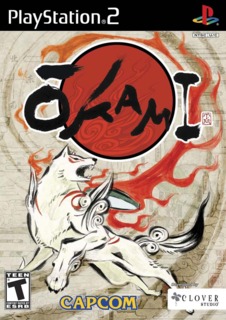A visual masterpiece with outstanding gameplay and plot, gives the PS2 the last hurrahs in the end of the 6th generation
As soon as you begin the game, you immediately notice the eye-popping graphics. Cel-shaded games have existed for years, but Okami is presented as a Japenese calligraphic mural. Therefore, every single scene in the game can be hung up on the wall as an artistic masterpiece. Some people consider cel-shading a step down from regular 3-D polygons, but Okami's unique, but necessary style shows that the PS2 can rival the ultra-high resolution of next generation gaming. Truly, Okami is graphically unparalleled. At first, Okami seems like the quintessential adventure game, where you typically explore towns and dungeons and defeat bosses. But it is much less formulaic than most games of this genre, especially because it adds unique, innovative aspects. First, a lot of the game seems like a traditional Final Fantasy-style RPG due to the stat management, heavy character interaction, deep character development, and large quantity of side quests. Even the battles resemble the Chrono RPG series, where battles occur by physically contacting 'Demon Scrolls', plunging Ameratasu into a small arena where you combat few monsters. Escaping requires you to find the 'weakness' in the arena wall and break out. Even after winning, you get a small screen showing your spoils and bonuses that depend on how quickly you dispatched the monsters and how much damage you took. However, the seamless, instantaneous transition in and out of battles is very non-RPG-esque. In addition, the combat is fully action based, no menus or gauges. Some of the battles are extremely action heavy, making the game seem more action based than anything else. One can therefore see the large mix of genres found in Okami.
Nevertheless, what truly makes this game unique is the Celestial Brush. Since Ameratasu is a god, she has the ability to "paint" the world as she sees it. Therefore, let's say it's night and you need daylight, simply pause time and literally paint a circle in the sky with the calligraphy brush, and a sun appears. Drawing a circle around a withered plant or tree causes it to bloom. You can fix a broken object by 'filling' in the missing parts. The powers extend from supportive skills to offensive attacks. Unlike most games where a simple menu selection or button sequence unleashes a skill, in Okami you actually paint the skill where you want it to occur. This way the game remains consistent to its artistic style. The Celestial Brush is revolutionary and truly extends the hand of the gamer.
As a god, your main job is to remedy all the world's problems and by doing so, the world returns praise. That idea is directly translated into the game. For example, blooming a withered tree, helping someone, feeding hungry animals gives Ameratasu Praise points. These points can be used to increase the 4 main stats: Solar Energy (health), Ink Levels (how much ink available for drawing), Astral Pouch (similar to extra lives), and Yen capacity (each upgrade increases the monetary capacity 10-fold). There are also 3 types of physical weapons, a Reflector, Beads, and Glaive, each having 2 different combat functions. Along with the Celestial Brush, which can be used in battle, Ameratasu has a full arsenal of weapons.
The music and sound of Okami is modernized Japenese music that truly fits with every scene of the game. The themes are memorable and adds to the flavor of the game in every aspect. The only downside in the entire game is perhaps the lack of voice acting. Instead, the text is "babbled" but it's not annoying or very noticeable. In fact, it seems the text is being spoken in Japanese. There are few other quirks that give this game the greatest praise. You will notice that there are loading screens in Okami, just like every game. However, each loading screen is a mini-game itself which awards you with a Demon Fang, used to buy valuable items. Other things like completing the game will unlock various content depending on how many game overs, how many animals fed, how much praise and money accumulated, etc. There is even a New Game+ feature which can restart the game with many of the previous games aspects.
One of the down sides of Okami is the game's difficulty. The main quest seems to last 40 hours but the completionist will take at least 60-70 hours on average, which is uniquely long for an adventure game. Anyways, the game is a bit easy through pass through, none of the battles, minor enemies or bosses, pose much difficulty at all. This is especially due to an item called the Vengance Slip that gives you temporary invincibility. However, some of the sidequests involve battles that are extremely difficult and long (one took over an hour), and fighting them without Vengeance Slips is a fool's aspiration.
Okami is a very entertaining game that every PS2 owner needs to own, not just rent. Many die-hard fans of the Zelda series are threatened by such a superior competitor, but in reality Okami stands alone as an innovative, unique and extremely rewarding gaming experience. It's definitely on the top 10 PS2 game list and a strong candidate for 2006 game of the year.

